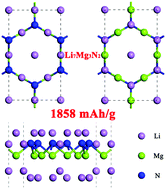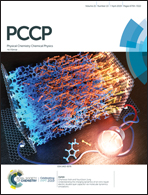Density functional theory prediction of Mg3N2 as a high-performance anode material for Li-ion batteries†
Abstract
Two dimensional (2D) materials have great potential for application in energy storage due to their unique structural characteristics. Here we propose for the first time a density functional theory study into the scientific feasibility of using g-Mg3N2, which is a novel graphene-like 2D material, as a high-capacity anode material for Li-ion batteries (LIBs). The favorable Li-adsorption geometries and the Li adsorption thermodynamics are explored in detail. It is found that monolayer g-Mg3N2 can be lithiated up to Li7Mg3N2 that offers a super high theoretical capacity of 1858 mA h g−1 and the average intercalation potential ranging from 0.2 to 0.7 V is suitable for anode applications. The metallic electronic structures of LixMg3N2, in combination with the low Li-ion diffusion energy barriers on the honeycomb structure, promote high electron and Li-ion conductivity to ensure fast charge/discharge cycling. The excellent structural stability of Mg3N2 is good for the cycling performance. These results predict that g-Mg3N2 can serve as a high-performance anode material for LIBs.



 Please wait while we load your content...
Please wait while we load your content...